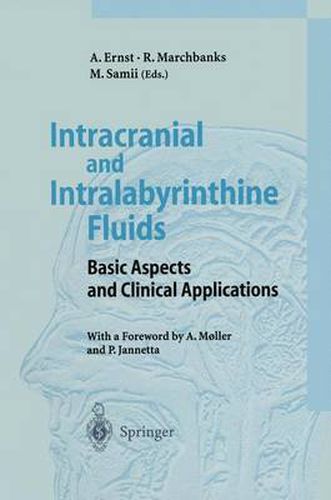Readings Newsletter
Become a Readings Member to make your shopping experience even easier.
Sign in or sign up for free!
You’re not far away from qualifying for FREE standard shipping within Australia
You’ve qualified for FREE standard shipping within Australia
The cart is loading…






This title is printed to order. This book may have been self-published. If so, we cannot guarantee the quality of the content. In the main most books will have gone through the editing process however some may not. We therefore suggest that you be aware of this before ordering this book. If in doubt check either the author or publisher’s details as we are unable to accept any returns unless they are faulty. Please contact us if you have any questions.
There is no question that the topic of this meeting in Seeheim, Germany, on intracranial and intralabyrinthine fluids is pertinent. This was the first international meeting at which these two closely-related topics were addressed together. Combining the clinical and research aspects of fluid and pressure regulation in the intracranial and the intralabyrint hine compartments as well as discussions on the clinical implications of abnormal fluid pressure was an excellent idea. The presentations and discussions of both the clinicians and basic scientists who participated proved that the concept of having such a combined focused gathering was both original and relevant. The two topics of the meeting in Seeheim have much in common. Maintaining both the intracranial pressure (lCP) and the intralabyrinthine pressure within normal limits is important for the normal functions of both the central nervous system and the ear. The intracranial space and the intralabyrinthine space are closed compartments that communicate with each other in an intricate manner. Deviations from normal intracranial pressure result in specific symptoms and signs. Medical problems related to elevated intracranial pressure vary from subtle to severe. Accumulated knowledge indicates that there are adverse effects from even relatively small elevations in ICP. Elevations in ICP may cause injuries to the brain and the ear. Abnormal pressure in the ear may cause abnormal function and injury. Maintaining the intracranial pressure within normal limits depends on a normally functioning pressure regulation.
$9.00 standard shipping within Australia
FREE standard shipping within Australia for orders over $100.00
Express & International shipping calculated at checkout
Stock availability can be subject to change without notice. We recommend calling the shop or contacting our online team to check availability of low stock items. Please see our Shopping Online page for more details.
This title is printed to order. This book may have been self-published. If so, we cannot guarantee the quality of the content. In the main most books will have gone through the editing process however some may not. We therefore suggest that you be aware of this before ordering this book. If in doubt check either the author or publisher’s details as we are unable to accept any returns unless they are faulty. Please contact us if you have any questions.
There is no question that the topic of this meeting in Seeheim, Germany, on intracranial and intralabyrinthine fluids is pertinent. This was the first international meeting at which these two closely-related topics were addressed together. Combining the clinical and research aspects of fluid and pressure regulation in the intracranial and the intralabyrint hine compartments as well as discussions on the clinical implications of abnormal fluid pressure was an excellent idea. The presentations and discussions of both the clinicians and basic scientists who participated proved that the concept of having such a combined focused gathering was both original and relevant. The two topics of the meeting in Seeheim have much in common. Maintaining both the intracranial pressure (lCP) and the intralabyrinthine pressure within normal limits is important for the normal functions of both the central nervous system and the ear. The intracranial space and the intralabyrinthine space are closed compartments that communicate with each other in an intricate manner. Deviations from normal intracranial pressure result in specific symptoms and signs. Medical problems related to elevated intracranial pressure vary from subtle to severe. Accumulated knowledge indicates that there are adverse effects from even relatively small elevations in ICP. Elevations in ICP may cause injuries to the brain and the ear. Abnormal pressure in the ear may cause abnormal function and injury. Maintaining the intracranial pressure within normal limits depends on a normally functioning pressure regulation.